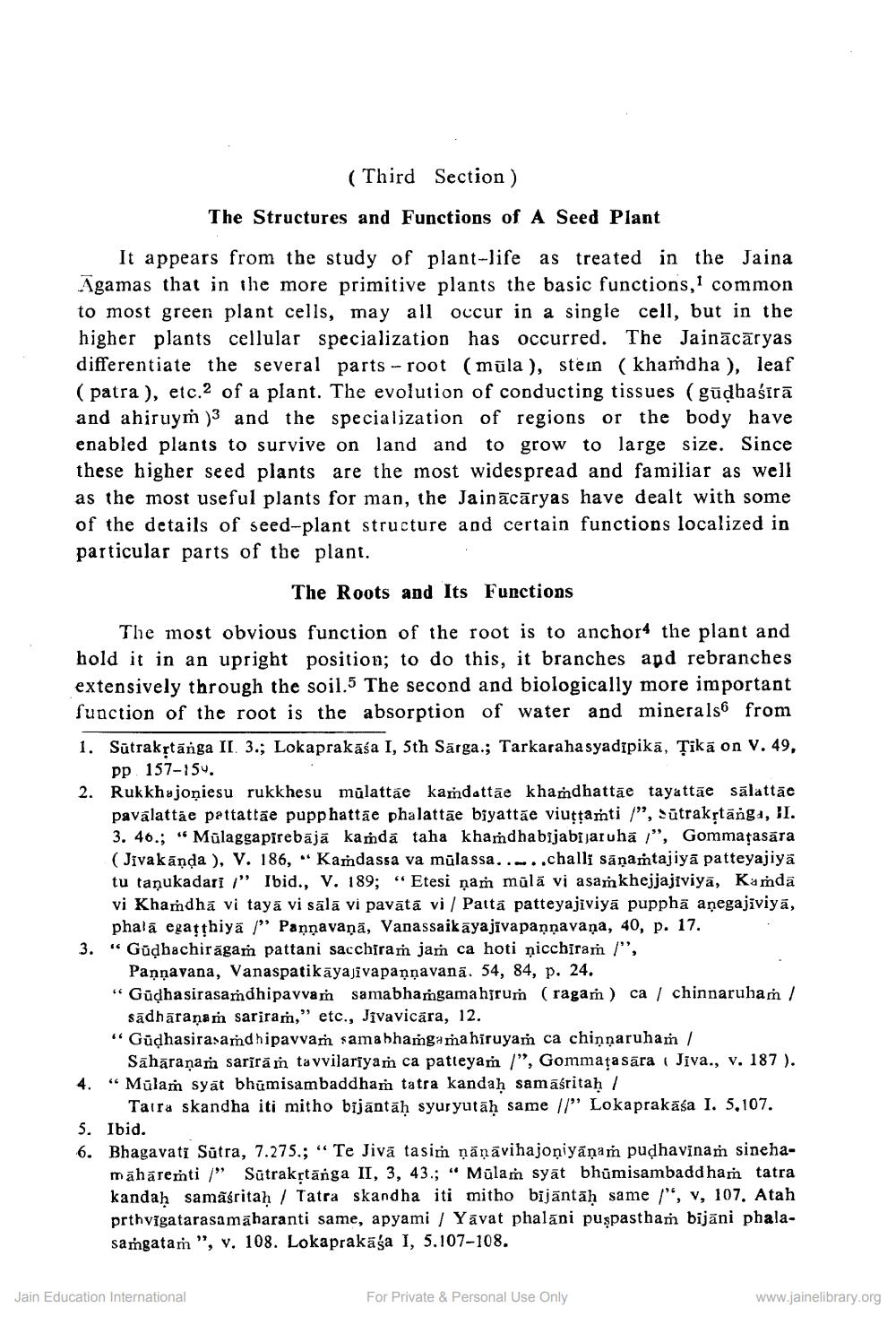________________
(Third Section)
The Structures and Functions of A Seed Plant
It appears from the study of plant-life as treated in the Jaina Agamas that in the more primitive plants the basic functions,1 common to most green plant cells, may all occur in a single cell, but in the higher plants cellular specialization has occurred. The Jainācāryas differentiate the several parts - root (mula), stem (khamdha), leaf (patra), etc.2 of a plant. The evolution of conducting tissues (gūḍhaśīrā and ahiruym)3 and the specialization of regions or the body have enabled plants to survive on land and to grow to large size. Since these higher seed plants are the most widespread and familiar as well as the most useful plants for man, the Jainacāryas have dealt with some of the details of seed-plant structure and certain functions localized in particular parts of the plant.
The Roots and Its Functions
The most obvious function of the root is to anchor the plant and hold it in an upright position; to do this, it branches and rebranches extensively through the soil.5 The second and biologically more important function of the root is the absorption of water and minerals from
1. Sūtrakṛtānga II. 3.; Lokaprakāśa I, 5th Sārga.; Tarkarahasyadīpikā, Tikā on V. 49, pp. 157-154.
2. Rukkhajoniesu rukkhesu mulattae kamdattae khamdhattae tayattae salattae pavalattae pattattae pupphattae phalattae biyattae viuṭṭamti /", Sutrakṛtānga, II. 3. 46.; "Mülaggapīrebājā kamda taha khaṁdhabijabijaruha /", Gommaṭasāra (Jivakanda ), V. 186, Kamdassa va mulassa....challi sanamtajiya patteyajiyä tu taņukadari /" Ibid., V. 189; "Etesi nam mūlā vi asamkhejjajiviya, Kamdā vi Khamdha vi tayā vi sālā vi pavātā vi / Pattā patteyajiviyā puppha aņegajiviya, phala egatthiya " Pannavaṇa, Vanassaik ayajivapanṇavana, 40, p. 17.
3. Gudhachiragam pattani sacchiram jam ca hoti nicchiram /",
Panṇavana, Vanaspatikāyajivapanṇavana. 54, 84, p. 24.
"Güḍhasirasamdhipavvam samabhaṁgama hirum (ragam) ca chinnaruhaṁ / sadharanam sariram," etc., Jivavicara, 12.
4.
"Güḍhasirasamdhipavvam sama bhamga mahiruyam ca chinṇaruham /
Sāhāraṇaṁ sarīrām tavvilariyam ca patteyam /", Gommaṭasara Jīva., v. 187 ). "Mūlam syat bhumisambaddham tatra kandaḥ samāśritaḥ /
Tatra skandha iti mitho bījāntāḥ syuryutaḥ same //" Lokaprakāśa I. 5.107.
5. Ibid.
6. Bhagavati Sūtra, 7.275.; "Te Jiva tasim näṇavihajoniyaṇam pudhavinam sinehamāhāremti/" Sūtrakṛtānga II, 3, 43.; " Mülam syat bhumisambadd ham tatra kandaḥ samasritaḥ / Tatra skandha iti mitho bijantaḥ same ", v, 107. Atah prthvigatarasamaharanti same, apyami / Yavat phalani puspasthaṁ bijāni phalasamgatam ", v. 108. Lokaprakaga I, 5.107-108.
Jain Education International
For Private & Personal Use Only
www.jainelibrary.org




